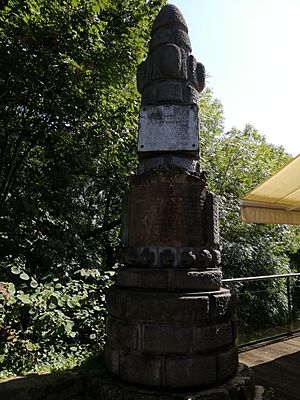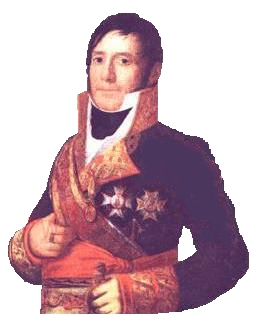Battle of San Marcial facts for kids
Quick facts for kids Battle of San Marcial |
|||||||
|---|---|---|---|---|---|---|---|
| Part of the Peninsular War | |||||||
 Monolith that recalls the battle of San Marcial |
|||||||
|
|||||||
| Belligerents | |||||||
| Commanders and leaders | |||||||
| Strength | |||||||
| 18,000 | 16,000 | ||||||
| Casualties and losses | |||||||
| 4,000 dead or wounded | 2,500 dead or wounded | ||||||
The Battle of San Marcial happened on August 31, 1813. It was one of the final battles fought in Spain during the Peninsular War. This war was a big conflict in Europe.
The battle took place at San Marcial, near Irún, close to the French border. Here, the Spanish Army of Galicia was led by General Freire. They stopped the last major attack by French Marshal Soult. Soult's attack was aimed at the army of Britain's Wellington.
Contents
Why Did the Battle of San Marcial Happen?
After the Vitoria campaign, Wellington's army moved towards San Sebastián. They started a siege of the city in July 1813. Wellington wanted to capture this important coastal fortress. The French army had retreated east after Vitoria.
San Sebastián and Pamplona were important cities. They protected the way into France. Wellington needed to take them from the French. However, the French soldiers defending San Sebastián were very strong. Their commander, General Rey, was determined. British attacks failed badly, with many soldiers hurt.
Before Wellington could try again, he heard news. Marshal Soult had quickly rebuilt the French army. Soult was back weeks earlier than Wellington expected. So, the allied armies stopped the siege to fight Soult.
Preparing for Battle: Who Was There?
While Wellington fought Soult at the Battle of the Pyrenees, Lieutenant General Graham kept San Sebastián surrounded. He got ready to restart the siege on August 26.
Soldiers built light defenses to stop Soult from helping San Sebastián. A strong line of troops was set up near the Bidasoa River. This line included British and Portuguese soldiers. It also had the Spanish 3rd, 5th, and 7th divisions on the San Marcial heights. Two brigades of the 4th division were also in reserve. These Spanish troops formed Freire's 4th Army, also known as the Army of Galicia.
After four weeks, Soult was ready for one last push. He gathered all nine of his divisions at Ainhoue. His plan was to attack near San Marcial.
Neither the French nor the Spanish soldiers were feeling great. The French were tired from recent retreats. They didn't really want to fight. Freire's Spanish troops were also struggling. They hadn't had enough food for days. Meanwhile, the allied army was fighting hard at San Sebastián. That day, August 31, they lost many soldiers there.
What Happened During the Battle?
On August 31, seven French divisions moved towards the Bidassoa River. It was early morning and misty. They crossed the river under the cover of their cannons. The allied positions at Vera and Irun were surprised. But they managed to warn General Freire.
Freire quickly got his Spanish troops into a line on the heights. The French soldiers struggled to climb the difficult ground. They reached Freire's line in a confused group. The Spanish soldiers met them with a strong volley of shots. Then, they charged with their bayonets. This forced Soult's leading divisions back down the hill.
Soult gathered his troops again around noon. He sent fresh soldiers for a second attack on the heights. But the Spanish soldiers held their ground. Their line of bayonets stayed strong against this final attack. The French soldiers were badly defeated.
Soult could not stop his men from retreating back over the river. He ordered a full withdrawal back to Irun. He called off his attack without fighting a single British soldier. Towards the end of the battle, Freire asked Wellington for help. Wellington replied that since Freire had already won, the Spanish should get all the credit. San Sebastián fell later that day after a very tough battle. Soult then retreated into France.
The Fight at Vera Bridge
In the afternoon, a big thunderstorm hit the area. Heavy rain caused the Bidassoa River to flood. By the time General Bertrand Clausel's French rearguard reached the river crossings, the water was six feet deep.
The rearguard commander, General Vandermaesen, led 10,000 men upstream to Vera (Bera). There was a bridge at Vera that was about 50 meters long. Only a few men could cross it at a time. But it was the only way out.
A small group of 70 British riflemen from the 95th Regiment held the village. They had two guards at the bridge. At 2:00 am on September 1, the French rushed the bridge. They crossed it but could not go any further. The heavy rain made their muskets unable to fire. So, they had to use their bayonets.
The British riflemen, however, had dry gunpowder. They were safe inside buildings with holes to shoot from. The French tried many times to rush the buildings. But the rifle fire stopped them.
The British captain, Daniel Cadoux, asked for help from a nearby brigade. But Major General Skerrett refused to send help. He even told Cadoux to leave his post. Cadoux refused and kept fighting. Skerrett repeated his order. Cadoux, who had only lost two guards, sadly got ready to leave.
But then it was dawn, and the rain stopped. The French gunpowder was now dry. As the British soldiers left the buildings, the French opened fire. Cadoux and 16 of his men were killed, and many more were hurt. The French left their cannons behind. They crossed the now unprotected bridge to escape. General Vandermaesen was among the dead.
What Happened After the Battle?
The Battle of San Marcial was the end for Soult's army. His soldiers were tired of war and sad. They had lost their fighting spirit. They never fought with their old skill and energy again.
The Spanish army's performance at San Marcial was one of its best in the Peninsular War. Other great Spanish efforts were at the Battle of Albuera and the Battle of Bailén. The next big fight would be the Battle of the Bidassoa on October 7.
See also
 In Spanish: Batalla de San Marcial (1813) para niños
In Spanish: Batalla de San Marcial (1813) para niños


